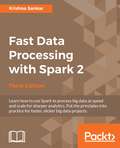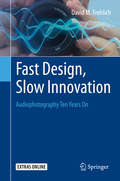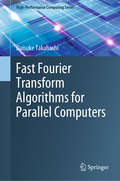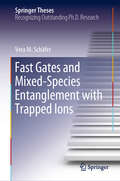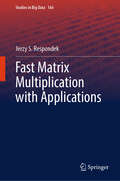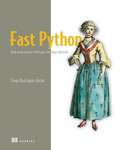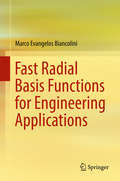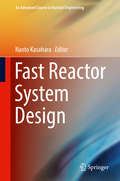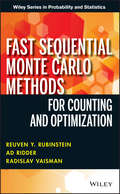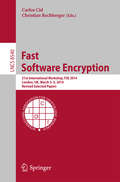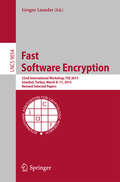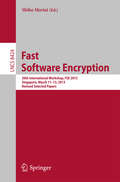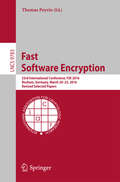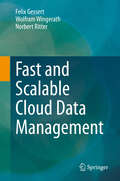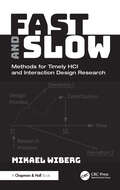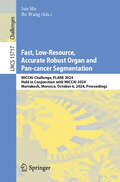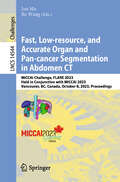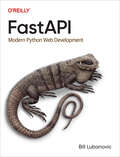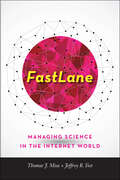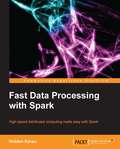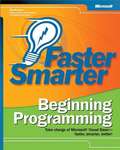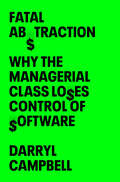- Table View
- List View
Fast Data Processing with Spark 2 - Third Edition
by Krishna SankarLearn how to use Spark to process big data at speed and scale for sharper analytics. Put the principles into practice for faster, slicker big data projects. About This Book * A quick way to get started with Spark - and reap the rewards * From analytics to engineering your big data architecture, we've got it covered * Bring your Scala and Java knowledge - and put it to work on new and exciting problems Who This Book Is For This book is for developers with little to no knowledge of Spark, but with a background in Scala/Java programming. It's recommended that you have experience in dealing and working with big data and a strong interest in data science. What You Will Learn * Install and set up Spark in your cluster * Prototype distributed applications with Spark's interactive shell * Perform data wrangling using the new DataFrame APIs * Get to know the different ways to interact with Spark's distributed representation of data (RDDs) * Query Spark with a SQL-like query syntax * See how Spark works with big data * Implement machine learning systems with highly scalable algorithms * Use R, the popular statistical language, to work with Spark * Apply interesting graph algorithms and graph processing with GraphX In Detail When people want a way to process big data at speed, Spark is invariably the solution. With its ease of development (in comparison to the relative complexity of Hadoop), it's unsurprising that it's becoming popular with data analysts and engineers everywhere. Beginning with the fundamentals, we'll show you how to get set up with Spark with minimum fuss. You'll then get to grips with some simple APIs before investigating machine learning and graph processing - throughout we'll make sure you know exactly how to apply your knowledge. You will also learn how to use the Spark shell, how to load data before finding out how to build and run your own Spark applications. Discover how to manipulate your RDD and get stuck into a range of DataFrame APIs. As if that's not enough, you'll also learn some useful Machine Learning algorithms with the help of Spark MLlib and integrating Spark with R. We'll also make sure you're confident and prepared for graph processing, as you learn more about the GraphX API. Style and approach This book is a basic, step-by-step tutorial that will help you take advantage of all that Spark has to offer.
Fast Design, Slow Innovation
by David M. FrohlichAs well as updating the manifesto for an audio photography technology and practice, this book addresses issues in design history, the social shaping of technology and the management of innovation. In particular, it reveals the very different timescales over which design and innovation operate, and the way in which design ideas evolve across different research groups, companies and application areas. The capture of photographs with sound is a simple idea, proposed 10 years ago, that has still not become widespread. In this new edition of the seminal 2004 book on Audio photography, the author asks "Why?" A journey through the book's citations and related commercial products shows considerable progress in understanding the role of sound in photography, and myriad design experiments to support audio visual storytelling as a new media form. The book is a story in itself about the "long nose of innovation", and a lesson about the need for patience and persistence in the computer industry. To reinforce this point five of the 2004 chapters are re-published in their original form. These describe invariant properties of ambient musical, talking and conversational photographs, and the possibility of playback from paper as well as screen. Fast Design, Slow Innovation will be of interest to researchers and designers of new media systems and experiences, and to innovation scholars or managers looking for a ten year case study of innovation in action.
Fast Fourier Transform Algorithms for Parallel Computers (High-Performance Computing Series #2)
by Daisuke TakahashiFollowing an introduction to the basis of the fast Fourier transform (FFT), this book focuses on the implementation details on FFT for parallel computers. FFT is an efficient implementation of the discrete Fourier transform (DFT), and is widely used for many applications in engineering, science, and mathematics. Presenting many algorithms in pseudo-code and a complexity analysis, this book offers a valuable reference guide for graduate students, engineers, and scientists in the field who wish to apply FFT to large-scale problems.Parallel computation is becoming indispensable in solving the large-scale problems increasingly arising in a wide range of applications. The performance of parallel supercomputers is steadily improving, and it is expected that a massively parallel system with hundreds of thousands of compute nodes equipped with multi-core processors and accelerators will be available in the near future. Accordingly, the book also provides up-to-date computational techniques relevant to the FFT in state-of-the-art parallel computers. Following the introductory chapter, Chapter 2 introduces readers to the DFT and the basic idea of the FFT. Chapter 3 explains mixed-radix FFT algorithms, while Chapter 4 describes split-radix FFT algorithms. Chapter 5 explains multi-dimensional FFT algorithms, Chapter 6 presents high-performance FFT algorithms, and Chapter 7 addresses parallel FFT algorithms for shared-memory parallel computers. In closing, Chapter 8 describes parallel FFT algorithms for distributed-memory parallel computers.
Fast Gates and Mixed-Species Entanglement with Trapped Ions (Springer Theses)
by Vera M. SchäferQuantum logic gates are the crucial information-processing operation of quantumcomputers. Two crucial performance metrics for logic gates are their precision andspeed. Quantum processors based on trapped ions have always been the touchstonefor gate precision, but have suffered from slow speed relative to other quantum logicplatforms such as solid state systems. This thesis shows that it is possible to acceleratethe logic "clock speed" from kHz to MHz speeds, whilst maintaining a precision of99.8%. This is almost as high as the world record for conventional trapped-ion gates,but more than 20 times faster. It also demonstrates entanglement generation in atime (480ns) shorter than the natural timescale of the ions' motion in the trap, whichstarts to probe an interesting new regime of ion trap physics.In separate experiments, some of the first "mixed-species" quantum logic gates areperformed, both between two different elements, and between different isotopes.The mixed-isotope gate is used to make the first test of the quantum-mechanical Bellinequality between two different species of isolated atoms.
Fast Kart, Slow Kart (Step into Reading)
by Apple JordanDisney's Wreck-It Ralph is a computer-animated feature film about a video game villain who wants nothing more than to be the good guy for a change. But when Ralph finally gets his chance, he discovers that being the hero isn't as easy as it looks. Soon the entire video game world is at stake, and if Ralph doesn't play to win, it could mean "Game Over" for every game in the arcade! This Step 1 reader based on the film is perfect for kids ages 4-6. Plus it comes with over 30 stickers!
Fast Matrix Multiplication with Applications (Studies in Big Data #166)
by Jerzy S. RespondekThe ambition of this monograph is to show the methods of constructing fast matrix multiplication algorithms, and their applications, in an intelligible way, accessible not only to mathematicians. The scope and coverage of the book are comprehensive and constructive, and the analyses and algorithms can be readily applied by readers from various disciplines of science and technology who need modern tools and techniques related to fast matrix multiplication and related problems and techniques. Authors start from commutative algorithms, through exact non-commutative algorithms, partial algorithms to disjoint and arbitrary precision algorithms. Authors explain how to adapt disjoint algorithms to a single matrix multiplication and prove the famous tau-theorem in the (not so) special case. In an appendix, authors show how to work with confluent Vandermonde matrices, since they are used as an auxiliary tool in problems arising in fast matrix multiplication. Importantly, each algorithm is demonstrated by a concrete example of a decent dimensionality to ensure that all the mechanisms of the algorithms are illustrated. Finally, authors give a series of applications of fast matrix multiplication algorithms in linear algebra and other types of problems, including artificial intelligence.
Fast Python: High performance techniques for large datasets
by Tiago AntaoMaster Python techniques and libraries to reduce run times, efficiently handle huge datasets, and optimize execution for complex machine learning applications. Fast Python is a toolbox of techniques for high performance Python including: Writing efficient pure-Python code Optimizing the NumPy and pandas libraries Rewriting critical code in Cython Designing persistent data structures Tailoring code for different architectures Implementing Python GPU computing Fast Python is your guide to optimizing every part of your Python-based data analysis process, from the pure Python code you write to managing the resources of modern hardware and GPUs. You'll learn to rewrite inefficient data structures, improve underperforming code with multithreading, and simplify your datasets without sacrificing accuracy. Written for experienced practitioners, this book dives right into practical solutions for improving computation and storage efficiency. You'll experiment with fun and interesting examples such as rewriting games in Cython and implementing a MapReduce framework from scratch. Finally, you'll go deep into Python GPU computing and learn how modern hardware has rehabilitated some former antipatterns and made counterintuitive ideas the most efficient way of working. About the Technology Face it. Slow code will kill a big data project. Fast pure-Python code, optimized libraries, and fully utilized multiprocessor hardware are the price of entry for machine learning and large-scale data analysis. What you need are reliable solutions that respond faster to computing requirements while using less resources, and saving money. About the Book Fast Python is a toolbox of techniques for speeding up Python, with an emphasis on big data applications. Following the clear examples and precisely articulated details, you&’ll learn how to use common libraries like NumPy and pandas in more performant ways and transform data for efficient storage and I/O. More importantly, Fast Python takes a holistic approach to performance, so you&’ll see how to optimize the whole system, from code to architecture. What&’s Inside Rewriting critical code in Cython Designing persistent data structures Tailoring code for different architectures Implementing Python GPU computing About the Reader For intermediate Python programmers familiar with the basics of concurrency. About the Author Tiago Antão is one of the co-authors of Biopython, a major bioinformatics package written in Python. Table of Contents: PART 1 - FOUNDATIONAL APPROACHES 1 An urgent need for efficiency in data processing 2 Extracting maximum performance from built-in features 3 Concurrency, parallelism, and asynchronous processing 4 High-performance NumPy PART 2 - HARDWARE 5 Re-implementing critical code with Cython 6 Memory hierarchy, storage, and networking PART 3 - APPLICATIONS AND LIBRARIES FOR MODERN DATA PROCESSING 7 High-performance pandas and Apache Arrow 8 Storing big data PART 4 - ADVANCED TOPICS 9 Data analysis using GPU computing 10 Analyzing big data with Dask
Fast Radial Basis Functions for Engineering Applications
by Marco Evangelos BiancoliniThis book presents the first “How To” guide to the use of radial basis functions (RBF). It provides a clear vision of their potential, an overview of ready-for-use computational tools and precise guidelines to implement new engineering applications of RBF. Radial basis functions (RBF) are a mathematical tool mature enough for useful engineering applications. Their mathematical foundation is well established and the tool has proven to be effective in many fields, as the mathematical framework can be adapted in several ways. A candidate application can be faced considering the features of RBF: multidimensional space (including 2D and 3D), numerous radial functions available, global and compact support, interpolation/regression. This great flexibility makes RBF attractive – and their great potential has only been partially discovered. This is because of the difficulty in taking a first step toward RBF as they are not commonly part of engineers’ cultural background, but also due to the numerical complexity of RBF problems that scales up very quickly with the number of RBF centers. Fast RBF algorithms are available to alleviate this and high-performance computing (HPC) can provide further aid. Nevertheless, a consolidated tradition in using RBF in engineering applications is still missing and the beginner can be confused by the literature, which in many cases is presented with language and symbolisms familiar to mathematicians but which can be cryptic for engineers. The book is divided in two main sections. The first covers the foundations of RBF, the tools available for their quick implementation and guidelines for facing new challenges; the second part is a collection of practical RBF applications in engineering, covering several topics, including response surface interpolation in n-dimensional spaces, mapping of magnetic loads, mapping of pressure loads, up-scaling of flow fields, stress/strain analysis by experimental displacement fields, implicit surfaces, mesh to cad deformation, mesh morphing for crack propagation in 3D, ice and snow accretion using computational fluid dynamics (CFD) data, shape optimization for external aerodynamics, and use of adjoint data for surface sculpting. For each application, the complete path is clearly and consistently exposed using the systematic approach defined in the first section.
Fast Reactor System Design
by Naoto KasaharaThis book describes the fast reactor (FR), a type of new reactor for nuclear plants, currently under research and development. The book targets young researchers and engineers who will be charged with commercializing this new type of reactor to lead to the development of new components and systems for improved plant reliability and economy. This volume also helps readers to understand the methods of integrating the power plant in its entirety, from the reactor core to all of the various systems and components, and teaches the way of thinking that forms the background of these methods. This background includes the various organizational and management issues that are encountered as projects move forward and will be explored in great detail based on actual design and construction experience with Japan's prototype FR, Monju.
Fast Sequential Monte Carlo Methods for Counting and Optimization
by Reuven Y. Rubinstein Radislav Vaisman Ad RidderA comprehensive account of the theory and application of Monte Carlo methodsBased on years of research in efficient Monte Carlo methods for estimation of rare-event probabilities, counting problems, and combinatorial optimization, Fast Sequential Monte Carlo Methods for Counting and Optimization is a complete illustration of fast sequential Monte Carlo techniques. The book provides an accessible overview of current work in the field of Monte Carlo methods, specifically sequential Monte Carlo techniques, for solving abstract counting and optimization problems.Written by authorities in the field, the book places emphasis on cross-entropy, minimum cross-entropy, splitting, and stochastic enumeration. Focusing on the concepts and application of Monte Carlo techniques, Fast Sequential Monte Carlo Methods for Counting and Optimization includes:Detailed algorithms needed to practice solving real-world problemsNumerous examples with Monte Carlo method produced solutions within the 1-2% limit of relative errorA new generic sequential importance sampling algorithm alongside extensive numerical resultsAn appendix focused on review material to provide additional background informationFast Sequential Monte Carlo Methods for Counting and Optimization is an excellent resource for engineers, computer scientists, mathematicians, statisticians, and readers interested in efficient simulation techniques. The book is also useful for upper-undergraduate and graduate-level courses on Monte Carlo methods.
Fast Software Encryption
by Carlos Cid Christian RechbergerThis book constitutes the thoroughly refereed post-conference proceedings of the 21st International Workshop on Fast Software Encryption, held in London, UK, March 3-5, 2014. The 31 revised full papers presented were carefully reviewed and selected from 99 initial submissions. The papers are organized in topical sections on designs; cryptanalysis; authenticated encryption; foundations and theory; stream ciphers; hash functions; advanced constructions.
Fast Software Encryption
by Gregor LeanderThis book constitutes the thoroughly refereed post-conference proceedings of the 22nd International Workshop on Fast Software Encryption, held in Istanbul, Turkey, March 8-11, 2015. The 28 revised full papers presented were carefully reviewed and selected from 71 initial submissions. The papers are organized in topical sections on block cipher cryptanalysis; understanding attacks; implementation issues; more block cipher cryptanalysis; cryptanalysis of authenticated encryption schemes; proofs; design; lightweight; cryptanalysis of hash functions and stream ciphers; and mass surveillance.
Fast Software Encryption
by Shiho MoriaiThis book constitutes the thoroughly refereed post-conference proceedings of the 20th International Workshop on Fast Software Encryption, held in Singapore, March 11-13, 2013. The 30 revised full papers presented were carefully reviewed and selected from 97 initial submissions. The papers are organized in topical sections on block ciphers, lightweight block ciphers, tweakable block ciphers, stream ciphers, hash functions, message authentication codes, provable security, implementation aspects, lightweight authenticated encryption, automated cryptanalysis, Boolean functions.
Fast Software Encryption
by Thomas PeyrinThis book constitutes the thoroughly refereed post-conference proceedings of the 23rd International Conference on Fast Software Encryption, held in Bochum, Germany, in March 2016. The 29 revised full papers presented were carefully reviewed and selected from 86 initial submissions. The papers are organized in topical sections on operating modes; stream-cipher cryptanalysis; components; side-channels and implementations; automated tools for cryptanalysis; designs; block-cipher cryptanalysis; foundations and theory; and authenticated-encryption and hash function cryptanalysis.
Fast and Low-Resource Semi-supervised Abdominal Organ Segmentation: MICCAI 2022 Challenge, FLARE 2022, Held in Conjunction with MICCAI 2022, Singapore, September 22, 2022, Proceedings (Lecture Notes in Computer Science #13816)
by Jun Ma Bo WangThis book constitutes the proceedings of the MICCAI 2022 Challenge, FLARE 2022, held in Conjunction with MICCAI 2022, in Singapore, on September 22, 2022. The 28 full papers presented in this book were carefully reviewed and selected from 48 submissions. The papers present research and results for abdominal organ segmentation which has many important clinical applications, such as organ quantification, surgical planning, and disease diagnosis.
Fast and Scalable Cloud Data Management
by Wolfram Wingerath Norbert Ritter Felix GessertThe unprecedented scale at which data is both produced and consumed today has generated a large demand for scalable data management solutions facilitating fast access from all over the world. As one consequence, a plethora of non-relational, distributed NoSQL database systems have risen in recent years and today’s data management system landscape has thus become somewhat hard to overlook. As another consequence, complex polyglot designs and elaborate schemes for data distribution and delivery have become the norm for building applications that connect users and organizations across the globe – but choosing the right combination of systems for a given use case has become increasingly difficult as well. To help practitioners stay on top of that challenge, this book presents a comprehensive overview and classification of the current system landscape in cloud data management as well as a survey of the state-of-the-art approaches for efficient data distribution and delivery to end-user devices. The topics covered thus range from NoSQL storage systems and polyglot architectures (backend) over distributed transactions and Web caching (network) to data access and rendering performance in the client (end-user).By distinguishing popular data management systems by data model, consistency guarantees, and other dimensions of interest, this book provides an abstract framework for reasoning about the overall design space and the individual positions claimed by each of the systems therein. Building on this classification, this book further presents an application-driven decision guidance tool that breaks the process of choosing a set of viable system candidates for a given application scenario down into a straightforward decision tree.
Fast and Slow: Methods for Timely HCI and Interaction Design Research
by Mikael WibergFast and Slow: Methods for Timely HCI and Interaction Design Research explores the dynamic interplay between rapid and reflective, or long-term vs. short-term research in human–computer interaction (HCI) and interaction design research. In an era where fast approaches to technical research are foregrounded, this book provides a critical examination of the temporalities at play in various research approaches – from long-term empirical studies to rapid prototyping. Ultimately, it asks the fundamental question of how to make timely research contributions and how to plan research projects to be timely in terms of impact.Drawing inspiration from fast and slow thinking, design thinking, and our ever-changing world, this book contrasts "fast" approaches – such as "quick-and-dirty" ethnography, prototyping, and AI-driven automation – with "slow" methodologies that emphasize ethnographic studies, longitudinal research, and participatory design. By working across the fast and slow approaches to research, the book helps researchers and practitioners navigate the trade-offs between efficiency and depth, rapid results, and reflection. Ultimately, the focus of the book is on timely research contributions.With a focus on research approaches, this book presents cases, methodological insights, and theoretical discussions that foreground the temporalities at play in HCI and interaction design research. It questions whether the rush to develop, iterate, and deploy can sometimes obscure critical insights about human behavior, emerging phenomena, ethical considerations, and long-term impact.Whether you are an HCI researcher, UX practitioner, or technology strategist, Fast and Slow: Methods for Timely HCI and Interaction Design Research offers a fresh perspective on how to plan and carry out HCI and interaction design research – over time.
Fast, Low-Resource, Accurate Robust Organ and Pan-cancer Segmentation: MICCAI Challenge, FLARE 2024, Held in Conjunction with MICCAI 2024, Marrakesh, Morocco, October 6, 2024, Proceedings (Lecture Notes in Computer Science #15717)
by Jun Ma Bo WangThis book constitutes the proceedings of the MICCAI 2024 Challenge, FLARE 2024, held in Conjunction with MICCAI 2024, in Marrakesh, Morocco, during October 2024. The 20 full papers included in this book were carefully reviewed and selected from 24 submissions. They describe the solutions the participants found for automatic abdominal organ and pan-cancer segmentation using the official training dataset released for this pupose. This challenge focuses on both organ and pan-cancer segmentation, including three subtasks: Subtask 1: Pan-cancer segmentation in CT scansSubtask 2: Abdominal CT organ segmentation on laptopSubtask 3: Unsupervised domain adaptation for abdominal organ segmentation in MRI Scans
Fast, Low-resource, and Accurate Organ and Pan-cancer Segmentation in Abdomen CT: MICCAI Challenge, FLARE 2023, Held in Conjunction with MICCAI 2023, Vancouver, BC, Canada, October 8, 2023, Proceedings (Lecture Notes in Computer Science #14544)
by Jun Ma Bo WangThis book constitutes the proceedings of the MICCAI 2023 Challenge, FLARE 2023, held in Conjunction with MICCAI 2023, in Vancouver, BC, Canada, on October 8, 2023. The 27 full papers presented in this book were carefully reviewed and selected from 37 submissions. The papers present research and results for abdominal organ segmentation which has many important clinical applications, such as organ quantification, surgical planning, and disease diagnosis.
FastAPI: Modern Python Web Development
by Bill LubanovicFastAPI is a young yet solid framework that takes advantage of newer Python features in a clean design. As its name implies, FastAPI is indeed fast, rivaling similar frameworks in languages such as Golang. With this practical book, developers familiar with Python will learn how FastAPI lets you accomplish more in less time with less code.Author Bill Lubanovic covers the nuts and bolts of FastAPI development with how-to guides on various topics such as forms, database access, graphics, maps, and more that will take you beyond the basics. This book also includes how-to guides that will get you up to speed on RESTful APIs, data validation, authorization, and performance. With its similarities to frameworks like Flask and Django, you'll find it easy to get started with FastAPI.Through the course of this book, you will:Learn how to build web applications with FastAPIUnderstand the differences between FastAPI, Starlette, and pydanticLearn two features that set FastAPI apart: asynchronous functions and data type checking and validationExamine new features of Python 3.8+, especially type annotationsUnderstand the differences between sync and async PythonLearn how to connect with external APIs and services
FastLane: Managing Science in the Internet World (Johns Hopkins Studies in the History of Technology)
by Thomas J. Misa Jeffrey R. YostThe unique history and development of FastLane, the central nervous system of the National Science Foundation.Since 2000, the National Science Foundation has depended upon its pioneering FastLane e-government system to manage grant applications, peer reviews, and reporting. In this behind-the-scenes account Thomas J. Misa and Jeffrey R. Yost examine how powerful forces of science and computing came together to create this influential grant-management system, assessing its impact on cutting-edge scientific research.Why did the NSF create FastLane, and how did it anticipate the development of web-based e-commerce? What technical challenges did the glitch-prone early system present? Did the switch to electronic grant proposals disadvantage universities with fewer resources? And how did the scientific community help shape FastLane? Foregrounding the experience of computer users, the book draws on hundreds of interviews with scientific researchers, sponsored project administrators, NSF staff, and software designers, developers, and managers.
Fastdata Processing with Spark
by Holden KarauThis book will be a basic, step-by-step tutorial, which will help readers take advantage of all that Spark has to offer.Fastdata Processing with Spark is for software developers who want to learn how to write distributed programs with Spark. It will help developers who have had problems that were too much to be dealt with on a single computer. No previous experience with distributed programming is necessary. This book assumes knowledge of either Java, Scala, or Python.
Faster Smarter Beginning Programming
by Jim BuyensNow you can write your own programs with Microsoft® Visual Basic® .NET--faster, smarter, and better. Dive in--this friendly, high-energy guide makes it easy to learn exactly what you need. Use the numbered steps, code listings, and expert tips to accelerate your programming productivity--and move on to doing the cool things you want to do! Learn basic concepts, syntax, and language elements Follow easy coding techniques to build your dexterity Write and run your first Visual Basic .NET program Use built-in functions and classes or create your own Design the user interface with Windows® Forms Program Web applications using Microsoft ASP.NET Access files and databases Debug and deploy your new programs
Faster Smarter Microsoft® Office System -- 2003 Edition
by Katherine MurrayNow you can do the things you do every day with Office--create reports, manage finances, send e-mail, and make a presentation--but do them faster, smarter, and better. Dive in! This friendly, focused guide shows the best ways to use the core features in your Office programs, so you spend more time doing and less time learning. Use the quick lists, numbered steps, and helpful examples to accelerate your productivity--and do the cool things you want to do! Discover how to: Get your e-mail, calendar, and work day under control Create professional-looking documents--from memos and invoices to complex reports Use spreadsheets and charts to analyze data and support decision making Produce and deliver a compelling presentation with great visuals and special effects Communicate and work together more effectively using enhanced collaboration features Quickly build a dynamic Web site with data-driven features Use XML to make your data go farther Share and reuse information among programs to simplify work and get better resultsLearn about Office the Faster Smarter way! 10-Second Summary--see what each chapter covers at a glance Fast Wrap-Up--review key points and takeaways from every chapter Real-World Examples--apply what you learn to real work, right now Aha! Tips--get insider tips and insights to fuel your productivity Top 10 Troubleshooting Solutions--find fast answers, right inside the cover!
Fatal Abstraction: Why the Managerial Class Loses Control of Software
by Darryl CampbellA tech insider explains how capitalism and software development make for such a dangerous mix. Software was supposed to radically improve society. Outdated mechanical systems would be easily replaced; programs like PowerPoint would make information flow more freely; social media platforms like Facebook would bring people together; and generative AI would solve the world’s greatest ills. Yet in practice, few of the systems we looked to with such high hopes have lived up to their fundamental mandate. In fact, in too many cases they’ve made things worse, exposing us to immense risk at the societal and the individual levels. How did we get to this point? In Fatal Abstraction, Darryl Campbell shows that the problem is “managerial software”: programs created and overseen not by engineers but by professional managers with only the most superficial knowledge of technology itself. The managerial ethos dominates the modern tech industry, from its globe-spanning giants all the way down to its trendy startups. It demands that corporate leaders should be specialists in business rather than experts in their company’s field; that they manage their companies exclusively through the abstractions of finance; and that profit margins must take priority over developing a quality product that is safe for the consumer and beneficial for society. These corporations rush the development process and package cheap, unproven, potentially dangerous software inside sleek and shiny new devices. As Campbell demonstrates, the problem with software is distinct from that of other consumer products, because of how quickly it can scale to the dimensions of the world itself, and because its inner workings resist the efforts of many professional managers to understand it with their limited technical background. A former tech worker himself, Campbell shows how managerial software fails, and when it does what sorts of disastrous consequences ensue, from the Boeing 737 MAX crashes to a deadly self-driving car to PowerPoint propaganda, and beyond. Yet just because the tech industry is currently breaking its core promise does not mean the industry cannot change, or that the risks posed by managerial software should necessarily persist into the future. Campbell argues that the solution is tech workers with actual expertise establishing industry-wide principles of ethics and safety that corporations would be forced to follow. Fatal Abstraction is a stirring rebuke of the tech industry’s current managerial excesses, and also a hopeful glimpse of what a world shaped by good software can offer.
